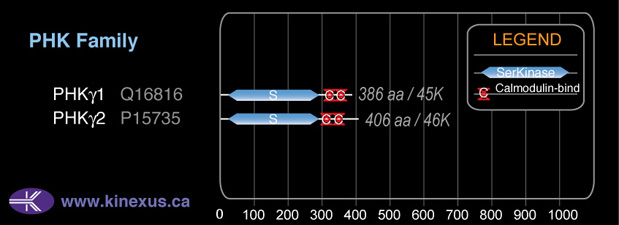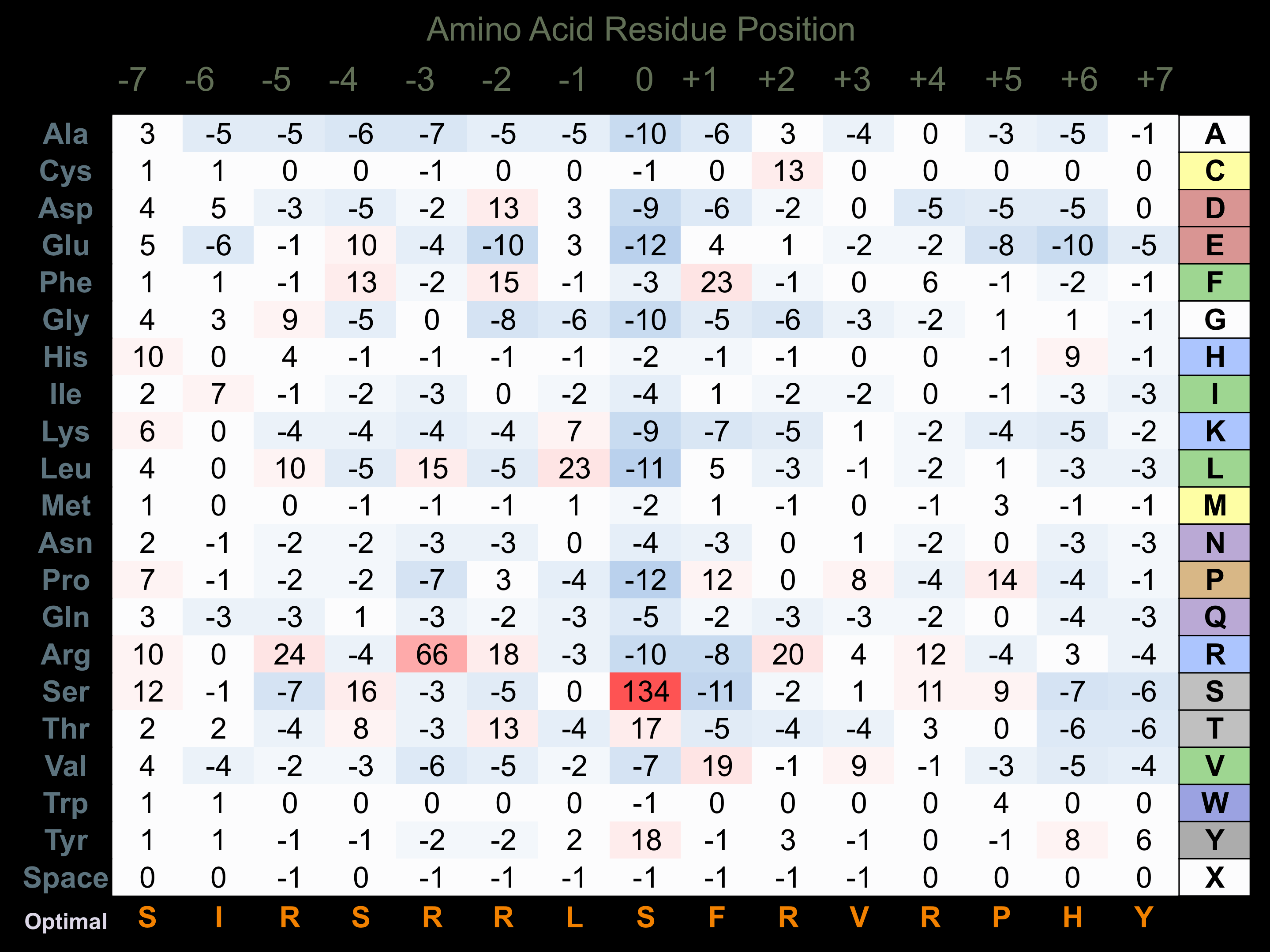Nomenclature
Short Name:
PHKg1
Full Name:
Phosphorylase b kinase gamma catalytic chain, skeletal muscle isoform
Alias:
- EC 2.7.11.19
- KPBG
- PHKG
- Skeletal muscle isoform
Classification
Type:
Protein-serine/threonine kinase
Group:
CAMK
Family:
PHK
SubFamily:
NA
Specific Links
Structure
Mol. Mass (Da):
45024
# Amino Acids:
387
# mRNA Isoforms:
2
mRNA Isoforms:
48,867 Da (419 AA; Q16816-2); 45,024 Da (387 AA; Q16816)
4D Structure:
Polymer of 16 chains, four each of alpha, beta, gamma, and delta. Alpha and beta are regulatory chains, gamma is the catalytic chain, and delta is calmodulin.
1D Structure:
Subfamily Alignment

Domain Distribution:
| Start | End | Domain |
|---|---|---|
| 20 | 288 | Pkinase |
| 342 | 366 | CaM_binding |
Kinexus Products
Click on entries below for direct links to relevant products from Kinexus for this protein kinase.
hiddentext
Post-translation Modifications
For detailed information on phosphorylation of this kinase go to PhosphoNET
Acetylated:
K262.
Methylated:
K304.
Serine phosphorylated:
S30, S31, S32, S81.
Threonine phosphorylated:
T140, T329.
Tyrosine phosphorylated:
Y337, Y338, Y350.
Distribution
Based on gene microarray analysis from the NCBI
Human Tissue Distribution
% Max Expression:
Mean Expression:
Number of Samples:
Standard Deviation:
% Max Expression:
Mean Expression:
Number of Samples:
Standard Deviation:
 70
70
850
22
1126
 4
4
50
11
35
 6
6
74
9
94
 36
36
439
79
1779
 32
32
389
22
309
 7
7
87
52
249
 18
18
221
29
534
 94
94
1146
30
2460
 14
14
167
10
155
 6
6
74
76
109
 8
8
93
22
120
 46
46
563
108
624
 5
5
61
20
82
 4
4
49
9
34
 4
4
54
10
32
 2
2
24
13
17
 5
5
58
114
46
 9
9
107
16
129
 29
29
348
76
264
 23
23
282
84
279
 8
8
101
18
64
 4
4
46
20
47
 7
7
83
16
66
 7
7
86
16
184
 5
5
63
18
81
 91
91
1108
54
2965
 4
4
45
23
47
 8
8
99
16
142
 5
5
61
14
73
 16
16
190
28
151
 48
48
583
18
407
 100
100
1213
32
2221
 47
47
574
62
933
 60
60
728
57
702
 3
3
32
35
24
Evolution
Species Conservation
PhosphoNET % Identity:
PhosphoNET % Similarity:
Homologene %
Identity:
PhosphoNET % Identity:
PhosphoNET % Similarity:
Homologene %
Identity:
 100
100
100
100 93.3
93.3
94.6
99.5 99
99
99.7
99 -
-
-
94 -
-
-
- 69.3
69.3
70.9
95 -
-
-
- 93.3
93.3
97.7
93.5 93.8
93.8
97.9
94 -
-
-
- -
-
-
- 31.1
31.1
46.8
81 31.8
31.8
47
77 29.4
29.4
42.2
74 -
-
-
- 27.7
27.7
44.1
- 51.6
51.6
68.4
- -
-
-
- 49.5
49.5
65
- -
-
-
- -
-
-
- -
-
-
- 25.8
25.8
43.8
- -
-
-
- -
-
-
-
For a wider analysis go to PhosphoNET Evolution in PhosphoNET
Binding Proteins
Examples of known interacting proteins
hiddentext
| No. | Name – UniProt ID |
|---|---|
| 1 | PHKG2 - P15735 |
| 2 | CTRC - Q99895 |
| 3 | CALM1 - P62158 |
| 4 | MAPT - P10636 |
Regulation
Activation:
NA
Inhibition:
NA
Synthesis:
NA
Degradation:
NA
Known Upstream Kinases
For further details on these substrates click on the Substrate Short Name or UniProt ID. Phosphosite Location is hyperlinked to PhosphoNET
predictions.
Based on in vitro and/or in vivo phosphorylation data
| Kinase Short Name | UniProt ID (Human) | Phosphosite Location | Phosphosite Sequence | Effect of Phosphorylation |
|---|
Known Downstream Substrates
For further details on these substrates click on the Substrate Short Name or UniProt ID. Phosphosite Location is hyperlinked to PhosphoNET
predictions.
Based on in vitro and/or in vivo phosphorylation data
| Substrate Short Name | UniProt ID (Human) | Phosphosite Location | Phosphosite Sequence | Effect of Phosphorylation |
|---|
| GAP43 | P17677 | S41 | AATKIQASFRGHITR | |
| GYS1 | P13807 | S8 | MPLNRTLSMSSLPGL | - |
| GYS2 | P54840 | S8 | MLRGRSLSVTSLGGL | - |
| Neurogranin | Q92686 | S36 | AAAKIQASFRGHMAR | |
| PHKA1 | P46020 | S1007 | TGIMQLKSEIKQVEF | |
| PHKA1 | P46020 | S972 | KEFGVERSVRPTDSN | |
| PHKA1 | P46020 | S985 | SNVSPAISIHEIGAV | |
| PHKg1 | Q16816 | S30 | EILGRGVSSVVRRCI | |
| PYGB | P11216 | S15 | SEKRKQISVRGLAGL | + |
| PYGL | P06737 | S15 | QEKRRQISIRGIVGV | + |
| PYGM | P11217 | S15 | QEKRKQISVRGLAGV | + |
| Tau iso8 | P10636-8 | S262 | NVKSKIGSTENLKHQ | |
| TNNT3 | P45378 | S1 | _______SDEEVEQV | |
| TNNT3 | P45378 | S159 | KKKKALSSMGANYSS | |
| TNNT3 | P45378 | S166 | SMGANYSSYLAKADQ |
Protein Kinase Specificity
Matrix of observed frequency (%) of amino acids in aligned protein substrate phosphosites

Matrix Type:
Predicted from the application of the Kinexus Kinase Substrate Predictor Version 2.0 algorithm, which was trained with over 10,000 kinase-protein substrate pairs and 8,000 kinase-peptide substrate pairs.
Domain #:
1
Inhibitors
For further details on these inhibitors click on the Compound Name and enter it into DrugKiNET or click on the ID's
Based on in vitro and/or in vivo phosphorylation data
| Compound Name | KD, Ki or IC50 (nM) | PubChem ID | ChEMBL ID | PubMed ID |
|---|
Disease Linkage
General Disease Association:
Musculoskeletal disorders
Specific Diseases (Non-cancerous):
Muscle glycogenosis; Phosphorylase kinase deficiency; Muscle phosphorylase kinase deficiency
Comments:
Mutations are associated with muscle-specific deficiency of phosphorylase kinase, which is causes glycogen storage disease, clinically manifesting in exercise intolerance with early fatigability, pain, cramps and occasionally myoglobinuria.
Gene Expression in Cancers:
TranscriptoNET (www.transcriptonet.ca) analysis with mRNA expression data retrieved from the National Center for Biotechnology Information's Gene Expression Omnibus (GEO) database, which was normalized against 60 abundantly and commonly found proteins, indicated altered expression for this protein kinase as shown here as the percent change from normal tissue controls (%CFC) as supported with the Student T-test in the following types of human cancers: Clear cell renal cell carcinomas (cRCC) stage I (%CFC= -86, p<0.0001); Skin melanomas - malignant (%CFC= -45, p<0.013); and Uterine leiomyomas (%CFC= +89, p<0.059). The COSMIC website notes an up-regulated expression score for PHKg1 in diverse human cancers of 424, which is 0.9-fold of the average score of 462 for the human protein kinases. The down-regulated expression score of 0 for this protein kinase in human cancers was 100% lower than the average score of 60 for the human protein kinases.
Mutagenesis Experiments:
Insertional mutagenesis studies in mice have not yet revealed a role for this protein kinase in mouse cancer oncogenesis.
Mutation Rate in All Cancers:
Percent mutation rates per 100 amino acids length in human cancers: 0.06 % in 24817 diverse cancer specimens. This rate is only -19 % lower than the average rate of 0.075 % calculated for human protein kinases in general.
Mutation Rate in Specific Cancers:
Highest percent mutation rates per 100 amino acids length in human cancers: 0.3 % in 603 endometrium cancers tested; 0.26 % in 589 stomach cancers tested; 0.26 % in 1270 large intestine cancers tested; 0.18 % in 864 skin cancers tested; 0.11 % in 1634 lung cancers tested; 0.1 % in 1276 kidney cancers tested; 0.07 % in 710 oesophagus cancers tested; 0.07 % in 382 soft tissue cancers tested; 0.07 % in 1512 liver cancers tested; 0.05 % in 1459 pancreas cancers tested.
Frequency of Mutated Sites:
None > 2 in 20,100 cancer specimens
Comments:
Only 1 deletion, and no insertions or complex mutations are noted on the COSMIC website.

